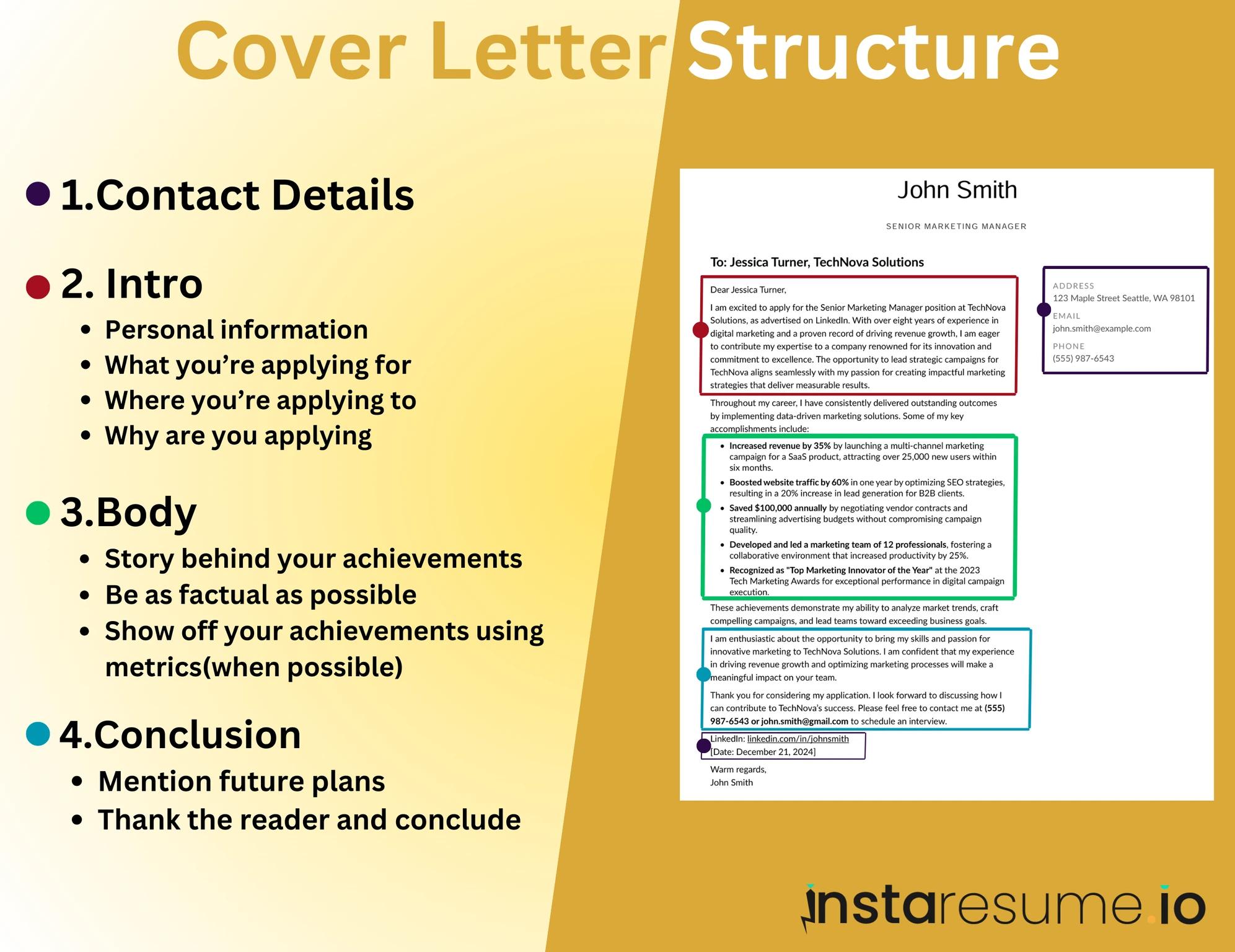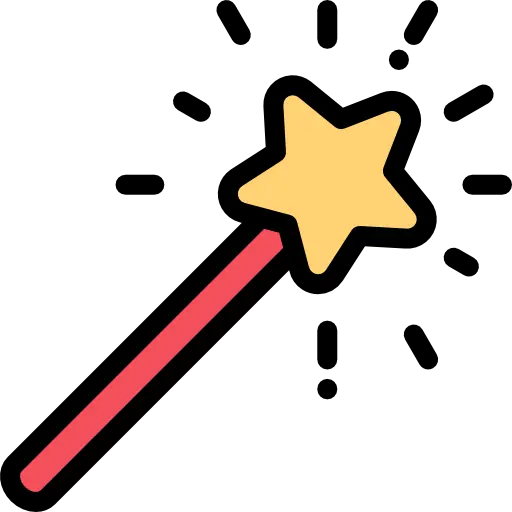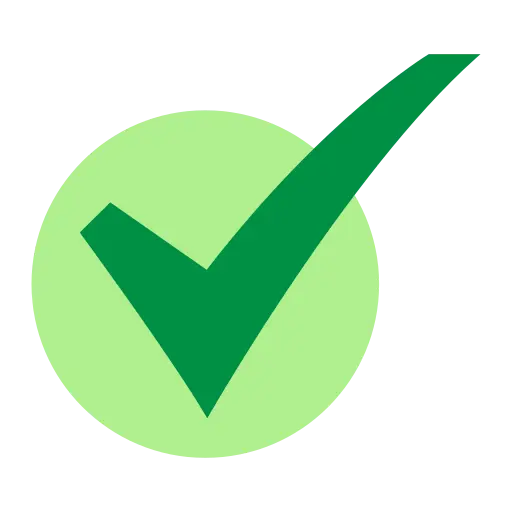How to write a cover letter [Full Guide & Examples for 2024]
Trust Score: 4.8
353 reviews
![How to write a cover letter [Full Guide & Examples for 2024]](..\blog-images/how-to-write-a-cover-letter/how-to-write-a-cover-letter-cover.webp)
Table of Contents
Introduction
After weeks of intense job hunting, you're almost at the finish line!
Your resume is polished and ready.
You've zeroed in on the most exciting job opportunities.
You've even prepped for every potential interview question with the help of a friend.
But just as you’re about to hit "send" on your application, you remember—you still need to write a cover letter.
Now you’re left staring at a blank screen, unsure of where to begin.
Don’t stress! Writing a cover letter is easier than you think.
In this guide, we’ll show you how to craft a cover letter that helps you land the job you deserve.
Here’s what we’ll cover:
 What a Cover Letter Is
What a Cover Letter Is A Step-by-Step Guide to Writing the Perfect Cover Letter
A Step-by-Step Guide to Writing the Perfect Cover Letter 15+ Winning Cover Letter Examples
15+ Winning Cover Letter Examples And much more!
And much more!
Let’s dive in!
When Should You Write a Cover Letter?
A cover letter is an essential part of many job applications and can be a powerful tool to differentiate yourself from other candidates. It allows you to introduce yourself in a personal way, explain your unique qualifications, and demonstrate your enthusiasm for the role. While it may not always be required, there are specific scenarios where writing a cover letter is particularly beneficial:
 The job posting explicitly requests one: If the employer asks for a cover letter, ensure you include it to meet their application requirements.
The job posting explicitly requests one: If the employer asks for a cover letter, ensure you include it to meet their application requirements. You’re applying via email or through a personal contact: A cover letter helps provide context and a professional introduction.
You’re applying via email or through a personal contact: A cover letter helps provide context and a professional introduction. You need to explain unique circumstances: Address topics like career transitions, employment gaps, or a desire to relocate.
You need to explain unique circumstances: Address topics like career transitions, employment gaps, or a desire to relocate. You want to showcase passion and fit: Highlight how your skills, values, and goals align with the company and position.
You want to showcase passion and fit: Highlight how your skills, values, and goals align with the company and position. When it’s optional but advantageous: Submitting a well-crafted cover letter even when not required can show initiative and professionalism.
When it’s optional but advantageous: Submitting a well-crafted cover letter even when not required can show initiative and professionalism.
By writing a thoughtful and tailored cover letter, you not only meet the requirements of the job but also create an opportunity to make a lasting impression on the hiring manager.
How to write a perfect cover letter for getting shortlisted
Now that you know when to write a cover letter, let's dive into how to write one that secures your spot in the interview round.
A well-crafted cover letter can set you apart from other candidates and make a compelling case for why you’re the best fit for the role. Below is a step-by-step guide to writing an impactful cover letter, complete with tips, examples, and subsections.
Contact Information in the Header
Begin with your contact details and the employer’s information. This includes:
 Your full name, address, phone number, and email.
Your full name, address, phone number, and email. Date of the letter.
Date of the letter. The hiring manager's name, job title, company name, and address.
The hiring manager's name, job title, company name, and address.
Example:
John Smith
123 Main Street
City, State, ZIP
[email protected] | (123) 456-7890
26th December 2024
Hiring Manager's Name
XYZ Corporation
456 Business Lane
City, State, ZIP
Addressing the Hiring Manager
Personalizing your salutation shows effort and professionalism. Address the hiring manager directly by name whenever possible.
Example:
 “Dear Ms. Jane Doe,”
“Dear Ms. Jane Doe,” “Dear Mr. Michael Johnson,”
“Dear Mr. Michael Johnson,” “Dear Hiring Team,” (if you cannot find a specific name)
“Dear Hiring Team,” (if you cannot find a specific name)
Give a Personal Touch
Start your introduction with enthusiasm and a genuine connection to the company or role. Mention why you’re excited about the position and how your skills align.
Example Introduction:
The Body: Details Matter
Use the main section of your cover letter to provide evidence of your achievements, aligning them with the job description.
 Quantify your achievements: Highlight results, such as percentages, revenue growth, or completed projects.
Quantify your achievements: Highlight results, such as percentages, revenue growth, or completed projects. Explain career gaps: Address employment gaps positively by focusing on skills you developed during that time.
Explain career gaps: Address employment gaps positively by focusing on skills you developed during that time.
Examples of Optimized Achievements in bullet points:
 Increased sales revenue by 25% in six months through targeted marketing strategies.
Increased sales revenue by 25% in six months through targeted marketing strategies. Successfully led a team of 10 to deliver a project three weeks ahead of schedule, saving the company $15,000.
Successfully led a team of 10 to deliver a project three weeks ahead of schedule, saving the company $15,000. Used a career break to complete a professional certification in data analytics, enhancing my technical expertise.
Used a career break to complete a professional certification in data analytics, enhancing my technical expertise.
Conclusion
End with a strong call to action. Reiterate your enthusiasm for the role and express your availability for an interview. Thank the hiring manager for considering your application.
Example Conclusion:
Streamline Your Writing with Instaresume’s Cover Letter Builder
Writing a cover letter can be time-consuming, but Instaresume’s Cover Letter Builder simplifies the process. With expertly designed templates tailored for every job, you can craft a professional and optimized cover letter in minutes. Each template is adaptable, ensuring your cover letter aligns perfectly with the role you’re applying for.
Take advantage of Instaresume’s tools to create a polished and standout cover letter effortlessly.
Explaining Why You’re the Perfect Candidate (Without Overselling)
When writing a cover letter, it’s essential to strike a balance between confidence and humility. Highlight your qualifications and achievements in a way that aligns with the job requirements without sounding boastful.
Tips for Showcasing Your Fit:
- Focus on the Employer's Needs
Frame your skills and experience in terms of how they can solve the company’s challenges or meet its goals. Instead of listing all your accomplishments, select those most relevant to the role.
Example:
- Use Specific Examples
Provide concrete examples of your achievements that demonstrate your ability to succeed in the role. Quantify results where possible to show measurable impact.
Example:
- Show Passion Without Overdoing It
Express genuine enthusiasm for the role and the company but avoid exaggerations. Employers appreciate authenticity over overly grandiose claims.
Example:
- Stay Humble and Collaborative
Emphasize teamwork and your willingness to learn. Acknowledge the company’s role in helping you grow while demonstrating how you can bring value to their team.
Example:
By focusing on how your skills, experience, and enthusiasm align with the employer’s needs, you can confidently present yourself as the ideal candidate without appearing overly self-promotional.
How a perfectly optimized cover letter should look
Comprehensive Checklist before sending cover letter to HR
Content Review
 Proofreading: Eliminate typos, grammatical errors, and awkward phrasing.
Proofreading: Eliminate typos, grammatical errors, and awkward phrasing. Tone and Professionalism: Ensure the email reflects a polite and professional tone.
Tone and Professionalism: Ensure the email reflects a polite and professional tone. Clarity: Clearly convey your message or request without unnecessary jargon.
Clarity: Clearly convey your message or request without unnecessary jargon.
Recipient and Subject Line
Recipient Details:
 Verify the recipient’s name, title, and email address.
Verify the recipient’s name, title, and email address. Confirm additional recipients in CC/BCC are correct and necessary.
Confirm additional recipients in CC/BCC are correct and necessary.
Subject Line:
 Make it concise, clear, and relevant to the email's purpose.
Make it concise, clear, and relevant to the email's purpose. Avoid using vague or overly general subject lines.
Avoid using vague or overly general subject lines.
Attachments
 Ensure all required documents (e.g., resumes, cover letters, portfolios, or supporting documents) are attached.
Ensure all required documents (e.g., resumes, cover letters, portfolios, or supporting documents) are attached. Verify file sizes are appropriate for email.
Verify file sizes are appropriate for email. Name files professionally (e.g., "John_Doe_Resume.pdf").
Name files professionally (e.g., "John_Doe_Resume.pdf").
Cover letter structure
Opening: Greet the recipient respectfully (e.g., "Dear [Name]").
Body:
 Stay focused on the main message or request.
Stay focused on the main message or request. Organize information with bullet points if necessary for readability.
Organize information with bullet points if necessary for readability.
Closing Statement: Clearly state next steps or desired outcomes.
Call to Action
Specify what you expect from the recipient (e.g., "Please confirm receipt," or "Let me know if additional information is required").
Signature
 Include your full name, title, and contact details.
Include your full name, title, and contact details. Add a professional sign-off (e.g., "Best regards," or "Sincerely").
Add a professional sign-off (e.g., "Best regards," or "Sincerely").
Technical Details
 Check all hyperlinks included in the email.
Check all hyperlinks included in the email. Avoid large attachments; use cloud storage links if needed.
Avoid large attachments; use cloud storage links if needed. Test the email on different devices for formatting consistency.
Test the email on different devices for formatting consistency.
Timing and Follow-Up
 Send the email at an appropriate time (e.g., during business hours).
Send the email at an appropriate time (e.g., during business hours). Consider scheduling the email if the recipient is in a different time zone.
Consider scheduling the email if the recipient is in a different time zone. Set a reminder for follow-up if no response is received within a reasonable time.
Set a reminder for follow-up if no response is received within a reasonable time.
Tips for Writing a Standout Cover Letter
Now you’re all set to write your cover letter!
Before you start typing, here are some cover letter tips to help take your cover letter to the next level:
Understand the Purpose of a Cover Letter
A cover letter is your chance to personalize your application and showcase your suitability for the role beyond what your resume conveys. Start with a clear understanding of the job requirements and align your cover letter to demonstrate how your skills meet those needs.
Research the Company
Researching the company shows genuine interest and helps you tailor your cover letter. Highlight their values, recent achievements, or ongoing projects that resonate with you, explaining how you can contribute to their goals.
Customize for Each Job
Avoid generic cover letters by tailoring each one for the specific role. Mention the job title, reference any specific requirements, and use the company’s language to show alignment with their culture.
Address the Hiring Manager
Whenever possible, address the hiring manager by name. This demonstrates effort and professionalism. If the name is unavailable, use a polite, formal greeting like “Dear Hiring Team.”
Start with a Strong Opening
Grab the reader’s attention with a compelling opening sentence. Mention your enthusiasm for the role, how you found out about it, or a relevant achievement that immediately showcases your value.
Highlight Relevant Skills and Experiences
Focus on soft skills and experiences directly related to the job description. Use specific examples that demonstrate your accomplishments and how they align with the employer's needs.
Showcase Enthusiasm
Employers want candidates who are genuinely excited about the role. Express your passion for the industry or specific tasks involved, showing that you’re motivated to contribute meaningfully.
Keep It Concise and Focused
A cover letter should be no longer than one page. Stick to key points, avoid unnecessary details, and make every sentence purposeful. Quality over quantity is essential.
Use a Professional Tone
Maintain a formal and respectful tone throughout your cover letter. Avoid slang, overly casual language, or excessive jargon that might detract from clarity and professionalism.
Include Measurable Achievements
Quantify your successes to give credibility to your claims. For instance, instead of saying “I increased sales,” say “I increased sales by 20% over six months.”
Demonstrate Cultural Fit
Employers value candidates who fit well within their organizational culture. Highlight attributes like teamwork, adaptability, or innovation that align with the company’s values.
Explain Career Transitions
If you’re changing careers or industries, use the cover letter to explain your motivations. Emphasize transferable skills and how they make you a strong candidate for the new role.
Avoid Overused Phrases
Phrases like “I’m the perfect candidate” or “My skills speak for themselves” can come across as presumptuous. Instead, focus on demonstrating your fit through specific examples.
End with a Call to Action
Conclude with a polite, confident request for the next step, such as scheduling an interview. Express appreciation for their time and reiterate your interest in the role.
Proofread Thoroughly
Typos and grammatical errors can leave a poor impression. Proofread your cover letter multiple times and consider having a trusted friend or professional review it for additional feedback.
15+ Cover Letter Examples
Need some inspiration? Check out some perfect cover letter examples for different experience levels and various professions.
5+ Cover Letter Examples by Experience
Looking for ideas? Explore outstanding cover letter examples tailored to various professions and experience levels.
1. College Student Cover Letter Example
2. Middle Management Cover Letter Example
3. Team Leader Cover Letter Example
4. Career Change Cover Letter Example
5. Management Cover Letter Example
9+ Cover Letter Examples by Profession
1. IT Cover Letter Example
2. Consultant Cover Letter Example
3. Human Resources Cover Letter
4. Business Cover Letter Example
5. Sales Cover Letter Example
6. Social Worker Cover Letter
7. Lawyer Cover Letter
8. Administrative Assistant Cover Letter
9. Engineering Cover Letter Example
10. Receptionist Cover Letter Example
Receptionist resume examples
Key takeaways:
 Personalization is Key: Tailor each cover letter to the specific job and company. This shows genuine interest and research, making your application stand out.
Personalization is Key: Tailor each cover letter to the specific job and company. This shows genuine interest and research, making your application stand out. Highlight Your Value: Focus on how your skills and experience directly benefit the company. Employers want to know what you bring to the table.
Highlight Your Value: Focus on how your skills and experience directly benefit the company. Employers want to know what you bring to the table. Be Concise and Clear: Keep your cover letter to one page. Make it easy to read by using clear and professional language.
Be Concise and Clear: Keep your cover letter to one page. Make it easy to read by using clear and professional language. Strong Opening & Closing: Start with an attention-grabbing introduction, and finish with a compelling call to action. Show enthusiasm for the position.
Strong Opening & Closing: Start with an attention-grabbing introduction, and finish with a compelling call to action. Show enthusiasm for the position. Proofread: Ensure your cover letter is free from errors. A well-written letter demonstrates your professionalism.
Proofread: Ensure your cover letter is free from errors. A well-written letter demonstrates your professionalism. Show Cultural Fit: Highlight why you'd be a great fit for the company culture, not just the role
Show Cultural Fit: Highlight why you'd be a great fit for the company culture, not just the role























